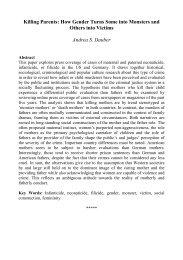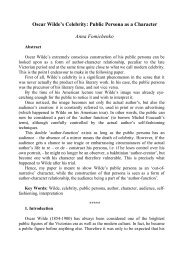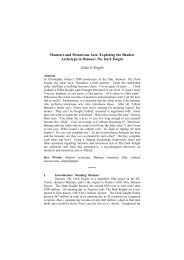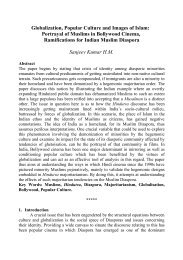The 'green-eyed monster': jealousy and erotic monomania in He ...
The 'green-eyed monster': jealousy and erotic monomania in He ...
The 'green-eyed monster': jealousy and erotic monomania in He ...
Create successful ePaper yourself
Turn your PDF publications into a flip-book with our unique Google optimized e-Paper software.
2 <strong>The</strong> ‘green-<strong>eyed</strong> monster’<br />
__________________________________________________________________<br />
Victorian fiction, present<strong>in</strong>g <strong>monomania</strong> fuelled rather than cured by marriage..<br />
Follow<strong>in</strong>g the fem<strong>in</strong>ist tradition, the failed-marriage plot is widely understood as concerned ‘primarily with the matter of<br />
female agency: it tends to revolve around a wife leav<strong>in</strong>g her husb<strong>and</strong>.’ 9 However, this view is predicated on the assumption<br />
that only female agency is restricted <strong>and</strong> problematized by n<strong>in</strong>eteenth-century marriage laws. I suggest that Trollope frame<br />
the failed-marriage plot primarily as a man’s plot. James Eli Adams has expla<strong>in</strong>ed the critical shy<strong>in</strong>g away from mascul<strong>in</strong>ity<br />
studies: it ‘has been resisted by those concerned that dwell<strong>in</strong>g on the complexities <strong>and</strong> burdens of mascul<strong>in</strong>e identity would<br />
serve to obscure, <strong>and</strong> thereby to re<strong>in</strong>force, the brute realities of male dom<strong>in</strong>ation aga<strong>in</strong>st which fem<strong>in</strong>ist analyses were <strong>and</strong><br />
are <strong>in</strong> the first place directed.’ 10 It also risks fall<strong>in</strong>g <strong>in</strong>to what Eve Kosofsky Sedgwick terms a ‘vast national wash of<br />
mascul<strong>in</strong>e self-pity.’ 11 By exam<strong>in</strong><strong>in</strong>g pathological male desire, <strong>in</strong>herently exacerbat<strong>in</strong>g female repression, this paper beg<strong>in</strong>s<br />
to redress gender imbalances <strong>in</strong> studies of Victorian psychology, illum<strong>in</strong>at<strong>in</strong>g <strong>in</strong>stances of male dom<strong>in</strong>ation, while resist<strong>in</strong>g<br />
the assumption that women were the only ‘victims’ of restricted agency <strong>in</strong> socio-psychological terms.<br />
Trollope’s writ<strong>in</strong>g is deeply rooted <strong>in</strong> n<strong>in</strong>eteenth-century psychological theory, 12 most notably Jean-Étienne Esquirol’s<br />
term ‘<strong>monomania</strong>’, a newly-identified form of <strong>in</strong>sanity. 13 This mania only showed itself when the patient thought or spoke<br />
about one particular subject: an idée fixe. 14 Esquirol’s conceptualisation of <strong>erotic</strong> <strong>monomania</strong> or ‘erotomania’ expla<strong>in</strong>s that<br />
‘ardent affections’, becom<strong>in</strong>g extreme, cause <strong>monomania</strong>cal symptoms. 15 Later def<strong>in</strong>itions described the violent symptoms<br />
shown <strong>in</strong> Galsworthy’s account. John Quackenbos, for <strong>in</strong>stance, writ<strong>in</strong>g a few months after Galsworthy, noted that<br />
erotomania, literally ‘rav<strong>in</strong>g love,’ may rema<strong>in</strong> <strong>in</strong> the imag<strong>in</strong>ation, but may be ‘grossly sensual’, perverted <strong>and</strong> quite<br />
repulsive. 16<br />
Jealousy as a forerunner of madness was explored previously <strong>in</strong> novels such as Charles Reade’s Griffith Gaunt (1866).<br />
Ellen Wood’s sensation novel, St. Mart<strong>in</strong>’s Eve (1866) discussed the theme occurr<strong>in</strong>g <strong>in</strong> a female character. <strong>The</strong> Spectator<br />
reviewed Wood’s novel, compla<strong>in</strong><strong>in</strong>g that madness was trivialised, be<strong>in</strong>g used as a mere plot device, <strong>and</strong> that the author<br />
lacked ‘the power to create Othello, or the art to pa<strong>in</strong>t, as Thackeray or Trollope might have done, the morbid passion <strong>in</strong> its<br />
naturalistic n<strong>in</strong>eteenth-century dress.’ 17 P. D. Edwards suggested that this review, together with Eliza Lynn L<strong>in</strong>ton’s Sow<strong>in</strong>g<br />
the W<strong>in</strong>d from 1867 may have <strong>in</strong>spired Trollope’s to write <strong>He</strong> Knew <strong>He</strong> Was Right. 18 In Trollope’s protagonist the illness<br />
takes an Esquirolian melancholic, relatively chaste form, while Galsworthy’s protagonist, presented <strong>in</strong> this paper as his<br />
literary successor, displays highly sexualised erotomania.<br />
<strong>He</strong> Knew <strong>He</strong> Was Right, the most detailed <strong>and</strong> extended portrait of male <strong>monomania</strong> <strong>in</strong> the Victorian canon, describes<br />
courtship <strong>in</strong> two pages, swiftly skipp<strong>in</strong>g to events two years after their marriage, contrary to Watt’s generalisation.<br />
Suspect<strong>in</strong>g <strong>in</strong>correctly that his wife is conduct<strong>in</strong>g an affair with her ag<strong>in</strong>g godfather, Colonel Osborne, Louis Trevelyan<br />
gradually becomes mad with <strong>jealousy</strong>: a deterioration Trollope repeatedly associates with mascul<strong>in</strong>ity. <strong>He</strong>re Trollope jo<strong>in</strong>s a<br />
contemporary cultural discourse which associated manl<strong>in</strong>ess with good health, physically <strong>and</strong> mentally, perceiv<strong>in</strong>g mental<br />
distress as weakness <strong>in</strong> mascul<strong>in</strong>ity. After Osborne’s first few visits to his wife, Trevelyan struggles with his irrationality:<br />
‘Though he believed himself to be a man very firm of purpose, his m<strong>in</strong>d had oscillated backwards <strong>and</strong> forwards… by some<br />
feel<strong>in</strong>g which pervaded him <strong>in</strong> reference to this man… his powers of m<strong>in</strong>d <strong>and</strong> body were paralysed.’ 19 At the novel’s<br />
open<strong>in</strong>g his agency was maximised, hav<strong>in</strong>g ‘all the world before him where to choose’… a very pearl among men,’ 20 <strong>in</strong><br />
stark contrast to the melancholic hermit, hid<strong>in</strong>g from his wife near Siena a few months later. Trevelyan develops the<br />
symptoms of erotomania described by Esquirol, appear<strong>in</strong>g dejected <strong>and</strong> pale.’ 21 Trollope’s diagnosis is explicit: Trevelyan is<br />
‘mono-maniacal’ 22 <strong>and</strong>, ‘<strong>in</strong> truth, mad on the subject of his wife’s alleged <strong>in</strong>fidelity.’ 23 At Trevelyan’s death bed, his doctor<br />
observes that ‘his patient’s thoughts had been forced to dwell on one subject’, becom<strong>in</strong>g ‘distorted, untrue, jaundiced…<br />
mono-maniacal,’ 24 before the narrator announces that ‘At last the maniac was dead.’ 25<br />
Trollope’s letters reveal that dur<strong>in</strong>g the writ<strong>in</strong>g of <strong>He</strong> Knew <strong>He</strong> Was Right he was <strong>in</strong> communication with psychologists,<br />
collect<strong>in</strong>g material for his fictional case study. Furthermore, there is evidence that this channel of <strong>in</strong>fluence was reciprocal<br />
<strong>in</strong> nature, with doctors read<strong>in</strong>g the novel as pseudo-authentic history of <strong>monomania</strong>. Trollope wrote to one physician, ‘I am<br />
gratified by the attention which your scientific analysis shews that you have given to the character of the unfortunate man

















